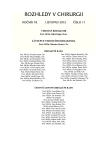Chest drainage methods
Authors:
M. Szkorupa; T. Bohanes
Authors‘ workplace:
I. chirurgická klinika LF UP a FN Olomouc, přednosta: doc. MUDr. Č. Neoral, CSc.
Published in:
Rozhl. Chir., 2013, roč. 92, č. 11, s. 666-671.
Category:
Various Specialization
Overview
Introduction:
The mastering of the chest drainage technique should be among the basic skills of any surgeon, pneumologist or critical care specialist. What is essential is the knowledge of the anatomy of the chest, the basic radiologic interpretation of pathological findings in the pleural cavity, and some manual skill. The possibility of complications occurring and the method of their treatment are also important.
Objective:
The aim of the article is to give an outline of the time aspect of the indication, necessary material equipment, the technique of chest drainage itself, differences in the drainage of pneumothorax, free and circumscribed effusion, caring for the chest drain following drainage and also of possible errors and mistakes that may occur. It also deals with methods of solving the complications.
Conclusion:
Chest drainage performed by a physician experienced in the chest drainage technique and keeping its basic principles may be considered to be a safe and effective method.
Keywords:
chest drainage – chest drain – technical equipment – methods – complications
Sources
1. Vašáková M, Žáčková P. Hrudní drenáže ...krok za krokem. Praha, Maxdorf 2012.
2. Yunus M. CT guided transthoracic catheter drainage of intrapulmonary abscess. J Pak Med Assoc 2009;59:703–709.
3. vanSonnenberg E, Nakamoto SK, Mueller PR, Casola G, Neff CC, Friedman PJ, Ferrucci JT Jr, Simeone JF. CT – and ultrasound-guided catheter drainage of empyemas after chest-tube failure. Radiology 1984;151:349–353.
4. Čapov I, et al. Drény a jejich využití v chirurgických oborech. 1. vyd. Praha, Grada 2001.
5. Matulová Š, et al. Použití a ošetřování hrudních drenážních systémů. Ošetřovatelství 2009;11:23–25.
6. Cooke DT, David EA. Large-bore and small-bore chest tubes: types, function, and placement. Thorac Surg Clin. 2013;23:17–24.
7. Laws D, Neville E, Duffy J. BTS guidelines for the insertion of a chest drain. Thorax 2003;58 Suppl 2:1153–1159
8. Galvin IF, Gibbons JRP, Magout M, et al. Placement of an apical chest tube by a posterior approach. Br J Hosp Med 1990;44:330–331.
9. Naicker TR, McLeod DT. P86 Chest Drain insertion training; is Simulation training the answer? Thorax 2010;65:A114.
10. Mellor DJ. A new method of chest drain insertion. Anaesthesia 1996;51:713–714.
11. Parmar JM. How to insert a chest drain. Br J Hosp Med 1989;42:231–3.
12. Davis JW, MacKersie RC, Hoyt DB, et al. Randomised study of algorithms for discontinuing tube thoracostomy drainage. J Am Coll Surg 1994;179:553–557.
13. Tang AT, Velissaris TJ, Weeden DF. An evidence-based approach to drainage of the pleural cavity: evaluation of best practice. J Eval Clin Pract 2002;8:333–340.
14. Hájek M. Traumatologie hrudníku. Praha, Avicenum 1980.
15. Niederle B, et al. Neodkladné speciální operace. Praha, Avicenum 1984.
Labels
Surgery Orthopaedics Trauma surgeryArticle was published in
Perspectives in Surgery

2013 Issue 11
Most read in this issue
- Chest drainage systems and the complications associated with drainage.
- Chest drainage methods
- Chest drainage – physiological and pathophysiological aspects and indications
- Reconstruction of complex abdominal wall defects using the component separation technique
